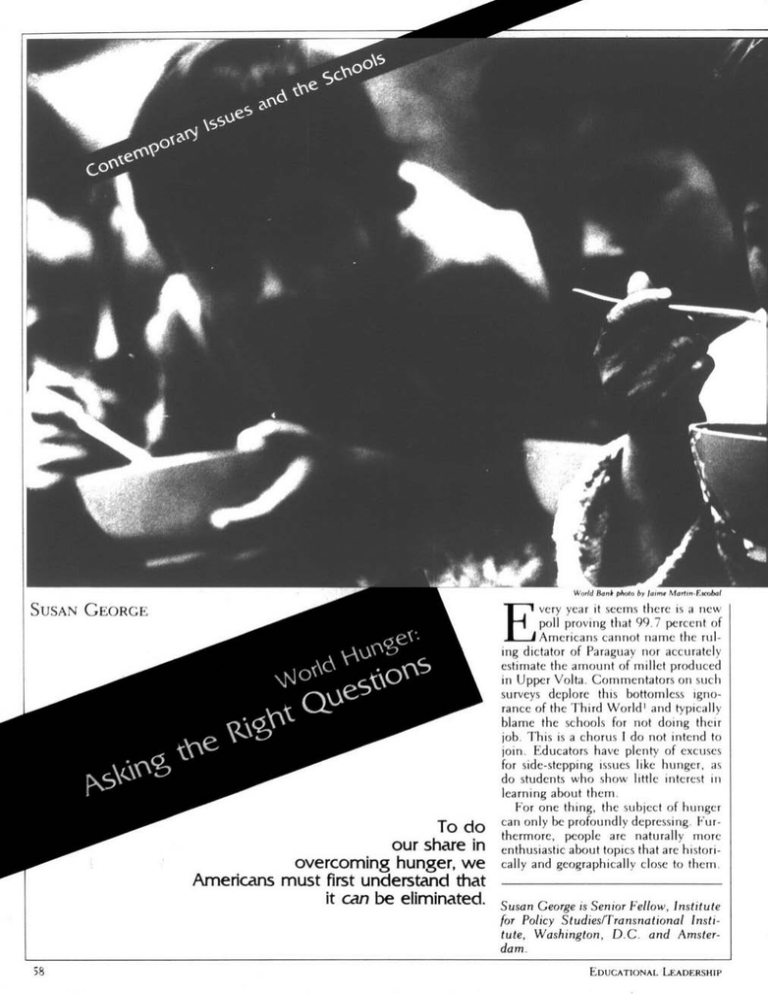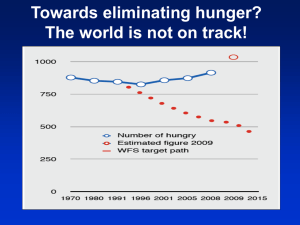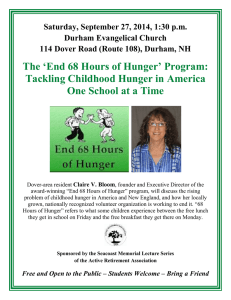
v
I3
World Hanbphoto by limor Martin-E.obfl
SUSAN GEORGE
To do
our share in
overcoming hunger, we
Americans must first understand that
it can be eliminated.
;8
poll proving that 99.7 percent of
Americans cannot name the ruling dictator of Paraguay nor accurately
estimate the amount of millet produced
in Upper Volta. Commentators on such
surveys deplore this bottomless ignorance of the Third Worldl and typically
blame the schools for not doing their
job. This is a chorus I do not intend to
join. Educators have plenty of excuses
for side-stepping issues like hunger, as
do students who show little interest in
learning about them.
For one thing, the subject of hunger
can only be profoundly depressing. Furthermore, people are naturally more
enthusiastic about topics that are historically and geographically close to them.
Susan George is Senior Fellow, Institute
for Policy Studies/Transnational Institute, Washington, D.C. and Amsterdam.
EDUCATIONAL LEADERSHIP
are not always those one might have
hoped!
Yet I doubt that these psychological
factors can durably dampen the interest
professional educators necessarilv take
in the world around them. We are, after
all, talking about three quarters of humanity, and about a "small planet" on
which other people's problems, sooner
or later, become our own. The best an
outsider can do for educators is to trv to
help them ask the right questions about
hunger and underdevelopment.
In the land of the overflowing refrigerator, hunger seems far away indeed. This
is not just an American trait. From
Australia to Zimbabwe, curricula understandably treat their own country as
the hub of the universe. 2 But curricular
ethnocentrism is perhaps more pronounced in the United States because of
its enormous size and relative isolation
from other nations; its huge economy;
and its real preeminence, for better or
worse, in world affairs.
America's prominence may itself give
rise to another motive for leaving some
Third World issues, including hunger,
in comparative limbo. If truth be told,
the U.S. (and Europe) has not always
played a shining role in the affairs of
Asia, Africa, and Latin America and
indeed have frequently worsened their
lot. Any serious examination of hunger
and poverty implies an equally serious
examination of abundance and wealth.
Not everyone takes kindly to analyses in
which the good guys and the bad guys
SEPTEMBER 1983
Can Hunger Be Eliminated?
The most important question is: Can
hunger be fought and eliminated? Must
we really be "depressed" by Third
World realitv? In one sense, the answer
is obvious, and the statistics never allow
us to forget it. The Food and Agriculture Organization of the United Nations
(FAO) reports that there are 450 million
malnourished people in Africa, India,
and Latin America. The World Bank's
estimate is 800 million "absolute poor."
UNICEF grimly and properly reminds
us, usually at Christmas, that 15 million
Third World children died of hunger or
hunger-related illness during the previous year. That comes to about 40,000 a
day. Such figures engender a sense of
helplessness. Who wouldn't feel power-
less in the face of such formidable numbers? Who wouldn't. after a lesson on
world hunger, feel pangs of guilt in front
of the next hamburger and french fries?
Who, finally, wouldn't make a point of
forgetting as rapidly as possible?
Yet hunger is not an insurmountable
problem. Consider these facts: There is
an average of 3,500,000 calories in one
ton of grain; 2,300 calories a day are
usually adequate for a proper adult diet.
Assuming that children should eat as
much as adults, at 2,300 calories x 365
days, one child would need 839,500
calories a year. Thus, one ton of grain
could feed 4. 17 children for an entire
vear; one million tons could feed over
four million children: and 3.6 million
tons of cereals could feed 15 million.
Three tons mav sound like a lot, but
in 1981 world grain harvests amounted
to over a billion and a half metric tons.
A mere three-and-some million tons
pale to insignificance when we calculate
that a paltry .002 percent of world harvests could save 15 million children.
And this assumes zero food resources
available locally.,leaving out even breast
milk. In the same vein, using the World
Bank's figure of 800 million absolute
poor, 2 percent of harvests would be
needed to feed all the people now going
hungry.
Figure 1. The Center and PeGrille
of Power Rebmonipe
ren-p
i
PsAphOss
r
TmE
CENp - Industrialized countries, and people who control eonoliolal power
Tm Pmwmms - Undenev loped countiies, and people who must subnit to the
decisions of those at the center. Arrows indicate the fow of power.
0
C.-41M $140 Ira &TM
Students and teachers should be disheartened by the gloom-and-doom tone
of most of the available material, which
invariably presents poor countries and
their people as eternally lacking something. The image conveyed, purposely
or not, is one of empty stomachs and
empty hands, probably outstretched in
hopes of alms. Sometimes the implication is that such people have empty
heads as well. The "backward peasant"
school of thought still thrives among
those who believe that Third World
people are too stupid to "modernize"
their farming systems along Western
lines; or that they insist on having more
children than they, or we, can afford to
feed. In the worst cases, we may believe
-
Sto
(or foreigners) occupies the richest flatland, the peasants who make up the
bulk of the population must make do
with second or third best, like the easily
eroded hillsides they are accused of
"overcultivating." When pastoralists are
no longer free to roam from pasture to
pasture because the best sites have been
fenced off for private use, they become
far more vulnerable to drought and
starvation. Because our own economy is
entirely monetized and because we have
such a small proportion of farmers in
our midst, we tend to forget that the
livelihood of the vast majority of Third
World people depends on having
enough land to provide food for one's
family. Fewer and fewer peasants can
that the poor threaten our own comfort compete with landholders who monopand security. Lyndon Johnson once in- olize not only land but also water,
formed his listeners that "there are three fertilizer, bank credit, and other vital
billion people in the world and we inputs not to mention political power.
[Americans] only have 200 million of
Such landholders also monopolize
them. We are outnumbered 15 to one. rural employment opportunities. If one
If might did make right, they would has no land, then one must find work in
sweep over the United States and take order to eat. Again, jobs are at a premiwhat we h've. We have what they um because so many peasants have
want. " ' Exposure to this kind of think- been expelled by landlords anxious to
ing is enough to tempt the most charita- farm larger and larger areas and because
ble spirit to impatience and exaspera- so many workers have been displaced by
tion: if poor people have that many ill-conceived "modemization" schemes,
problems, it must be, to put it gently, frequently financed by foreign aid. The
their own damn fault.
International Labour Organization reWhy should so many sources subtly ports at least 300 million unemployed or
or less subtly encourage us to blame the seriously
under-employed
people
victims? And why do they so seldom among the "active" population of the
mention the positive? The major obsta- Third World, and expects the figure to
cle to understanding world hunger is the reach one billion by the end of the
refusal to ask questions that are political century. Paradoxically, most hungry
in the broadest sense. Third World peo- people live where the food is prople, whatever our public or private im- duced-in the countryside. If they have
agery, are not unfilled bellies and grasp- too little land or have lost it altogether,
ing hands, but human beings who have if they have no further hope of employto their credit cultural achievements as ment there, they must take their
praiseworthy as our own, and who have chances in cities that have already befound remarkable and original ways of come uninhabitable for all but the privimaking a livelihood in a variety of leged minority. This means even more
unhospitable environments. The cause mouths to be fed by a dwindling numof much hunger and poverty lies in the ber of producers.
inability of such people, through no
Many countries have maintained cofault of their own, to continue practices lonial patterns of raising crops for exthat traditionally kept their resources port, to the detriment of food self-suffirenewable and their families alive.
ciency. They now furnish us not only
with the traditional coffee, tea, and
Economics of Hunger
cocoa, but also with off-season fruits,
What do hungry people really lack? vegetables, flowers, seafoods, and much
Power. When a minority of landowners of the meat served in our fast-food
60
60
emporiums. According to FAO, rich
countries' citizens pay about $200 billion a year for food products that originate in the Third World. The producer
nations get only $30 billion, or 15
percent; the peasant producers get far
less.
When cash crops take priority for
land, labor, and financing, the amount
of each devoted to food crops diminishes. This in turn reduces the total
amount of food available and makes it
more expensive. 'The poorest people
may well be cut out of the marketthough they may find a job for a few
weeks at miserable wages harvesting
someone else's sugar or coffee.
A world so proud of its science, technology, and management skills should
make child's play of saving 15 million
children and assuring every human being on earth of an adequate diet. There
is already enough food to provide for us
all, plus enough land, water, and knowhow to keep producing food for as long
as anyone can see. If chronic hunger
continues, one logical conclusion is that
its causes lie beyond science, technology, and management, and in the realm
of power relationships, locally, nationally, and internationally. A powerless
peasant must accept the dictates of the
local landlord. A powerless country will
continue to provide cheap agricultural
raw materials that are processed elsewhere. What responsibilities do affluent
countries bear in this state of affairs?
The U.S. as Bad Guy
Lord Beaverbrook, instructing his journalists, is said to have told them: "One
death in England, ten deaths on the
Continent, ten thousand deaths in India
is news. Nothing ever happens in
Chile." Beaverbrook was wrong. Things
do happen in Chile, many of them are
related to food and hunger, and some of
them affect us. Salvador Allende's government made great strides in eliminating malnutrition in Chile by redistributing income to the poorest half of the
population. This was, unfortunately, a
mixed blessing. Food demand leaped
way ahead of Chile's own capacity to
provide it, because people could afford,
for the first time, to buy enough for
Continued on page 62
LEADERSHIP~~~~~~~
EDUCA~~~~~~~~~~~~iONAL
EDUCATIONAL LEADERSHIP
&SC 12-211
s
proper nourishment. Chile needed food
imports, but U.S. banks cut off all loans
and no wheat was available on credit
from the transnational grain companies.
Shortages and inflation ensued, creating
a fertile field for the "destabilization"
activities of the CIA, ITT, and their
cohorts.
Perhaps the biggest Third World story
of the decade was the Iranian hostage
crisis, which had incalculable effects on
American politics and society. What
few Americans realized (and what the
formidable media coverage certainly
never told them) was the relationship
between Iranian food dependency and
the rise of a certain Ayatollah. The
U.S.-supported land "reform" in Iran
during the 60s resulted in the dispossession of some 25 percent of the Iranian
peasantry, with its attendant cortege of
unemployment and dependency on
food imports from the United Stateshalf a billion dollars worth in 1978.
American agribusiness corporations invested massively in several Iranian provinces, profoundly disrupting local patterns of rural life. Such activities
enhanced Iranian paranoia, already fed
by a hundred years of conflict with
British and American intervention (concessions for minerals, tobacco, oil, and
so on, beginning in the late 19th century had always been opposed). Food dependency and the destruction of the
peasantry were major themes in Khomeini's speeches. We are ethnocentric
at our peril.
One of the few countries to have
made significant progress in eliminating
hunger in recent years is Nicaragua.
Basic grain production was increased by
one-third in a single year after the victory of the Sandinistas-by simply providing more land, fertilizer, and credit
to small farmers and using land previously owned by the Somoza clan (fully
25 percent of the total!) for state farming
enterprises. Once again, the United
States is doing everything possible to
wreck this experiment, through military
and other means.
Power Plays in the Global Nation
If we are not prepared to admit that the
elimination of hunger depends primarily on redistribution of power, then we
are, so to speak, stuck with the tradition62
al explanations--overpopulation, climate, and the like. The model in Figure
I explains present power relationships;
educators may want to add their own
refinements.
Every country in the world has a
"center" made up of those who control
economic/political power, and a "periphery" of people who do not control
the circumstances of their lives and who
must submit to the decisions of those at
the center. There are, of course, numerous subdivisions for each category
This kind of model is also reproduced
on a world scale, in which the richer
and more powerful nations are generally
in a position to dictate their own terms
to the weaker and less developed ones.
As the "power arrows" in the diagram
show, the center of the center largely
controls the center of the periphery,
which, in turn, takes on the job of
controlling its own periphery.
Naturally, in order to ensure the continued functioning of a global system
that provides substantial monetary and
political gains to the minority, the center's center may make concessions to its
peripheral counterparts when the need
arises. Thus those who complain that
"food aid never reaches the hungry people" have a real point. It's entirely true
that much food aid buttresses the power
of Third World elites. So does bilateral
or multilateral aid (of the World Bank,
for example), which so often goes to
authoritarian or downright repressive regimes that have little interest in the
nutritional needs of their own popula-
tions. We also know that serious hunger
and malnutrition exist on the periphery
of the center, particularly when unemployment is high and benefits like food
stamps can be cut with impunity.
What Can Be Done?
If it's true that hunger can be conquered, that it is not an intractable
problem, then the questions become
"Why does it still exist?" and "What can
I do about it?" The sad, cynical, yet
accurate reply to the first question is that
those 15 million children and those 800
million "absolute poor" are of precious
little interest to a world system that
regards food not as a basic human right
but as a commodity to be bought and
sold. People who are unable to become
Consumers with a capital "C" have no
influence whatever on a system that is
programmed to understand the language of money.
As to the second question, the collective task for all concerned is to reverse
the direction of the "power arrows."
Any measure that helps poor people in
poor countries build countervailing
power in order to satisfy their own needs
deserves our support. Any action that
helps prevent the center's center from
doing exactly as it pleases to the periphery-with or without the cooperation of
local elites-is a positive one.
One recent example is the baby-foods
campaign that obligated the World
Health Organization to adopt a code
that constrains, at least morally, the
Third World marketing malpractices of
the infant formula corporations. Another was food aid to the Cambodian people. None of the major center countries
nor the agencies they largely control
wanted, for wholly indefensible political
reasons, to undertake such aid. The
force of public opinion made the difference.
The area in which the most work
remains to be done is that of establishing
better and closer ties between the two
peripheries in order to counterbalance
those ties already forged between the
centers. I am convinced that these peripheries share basically the same interests, but this we cannot always clearly
perceive. Educators could be a tremendous force in helping to create those
links, beginning with the links of understanding, and could thus contribute to
ending the scandal of world hunger.[l
References
'There is, of course, no such thing. The
term is merely convenient shorthand for a
huge variety of peoples and nations on the
continents of Africa, Asia, and Latin America. It implies no value judgments.
2
Not entirely a bad thing and not always,
alas, the practice in ex-colonies. West African school children, for example, have been
heard reciting a history lesson that begins,
"Our ancestors, the Gauls . ."
'Quoted in Noam Chomsky, "The Logic
of Withdrawal," in American Power and the
New Mandarins (New York: Pantheon
Books, 1969), p. 249
EDUCATIONAL LEADERSHIP
EDUCATIONAL LEADERSHIP
Copyright © 1983 by the Association for Supervision and Curriculum
Development. All rights reserved.



